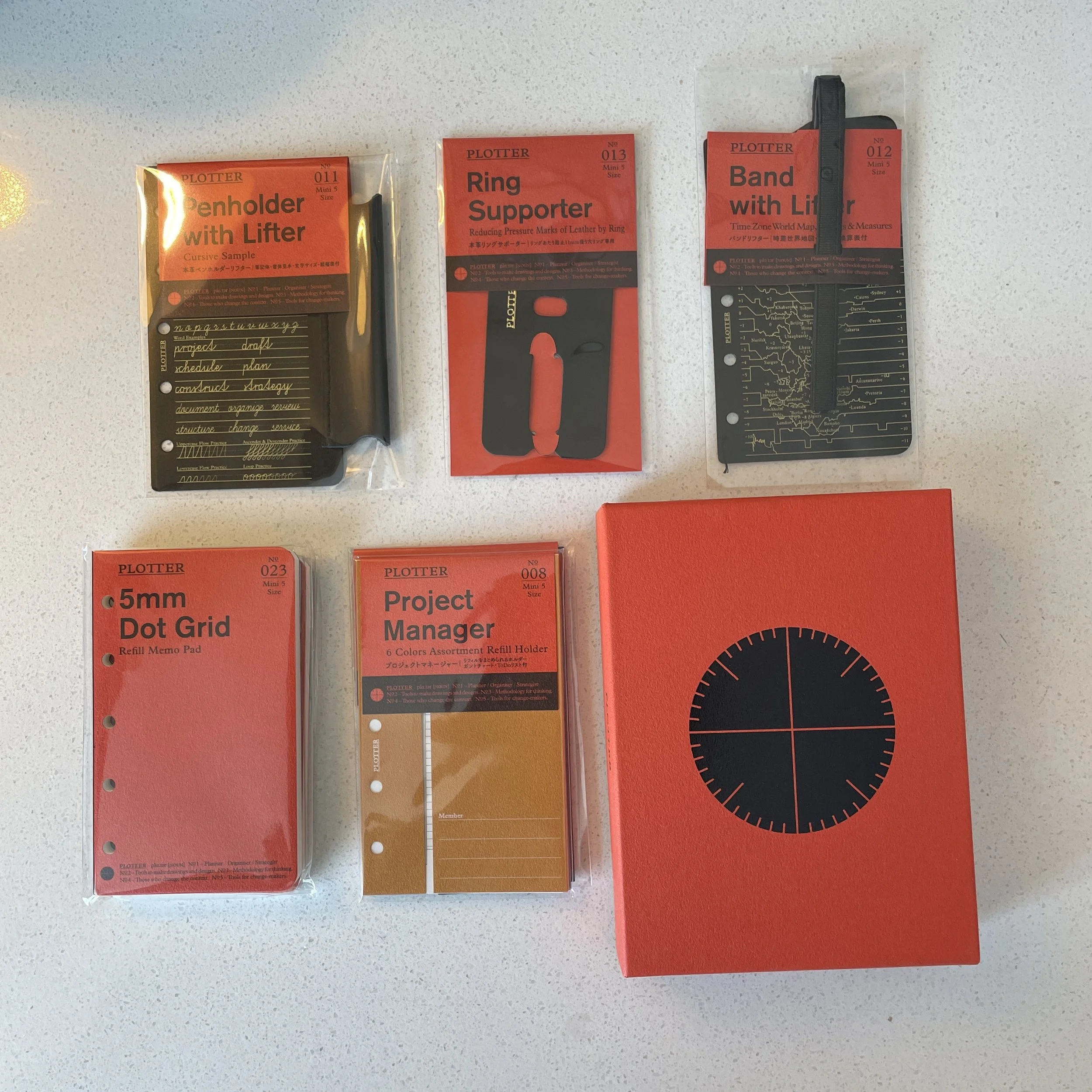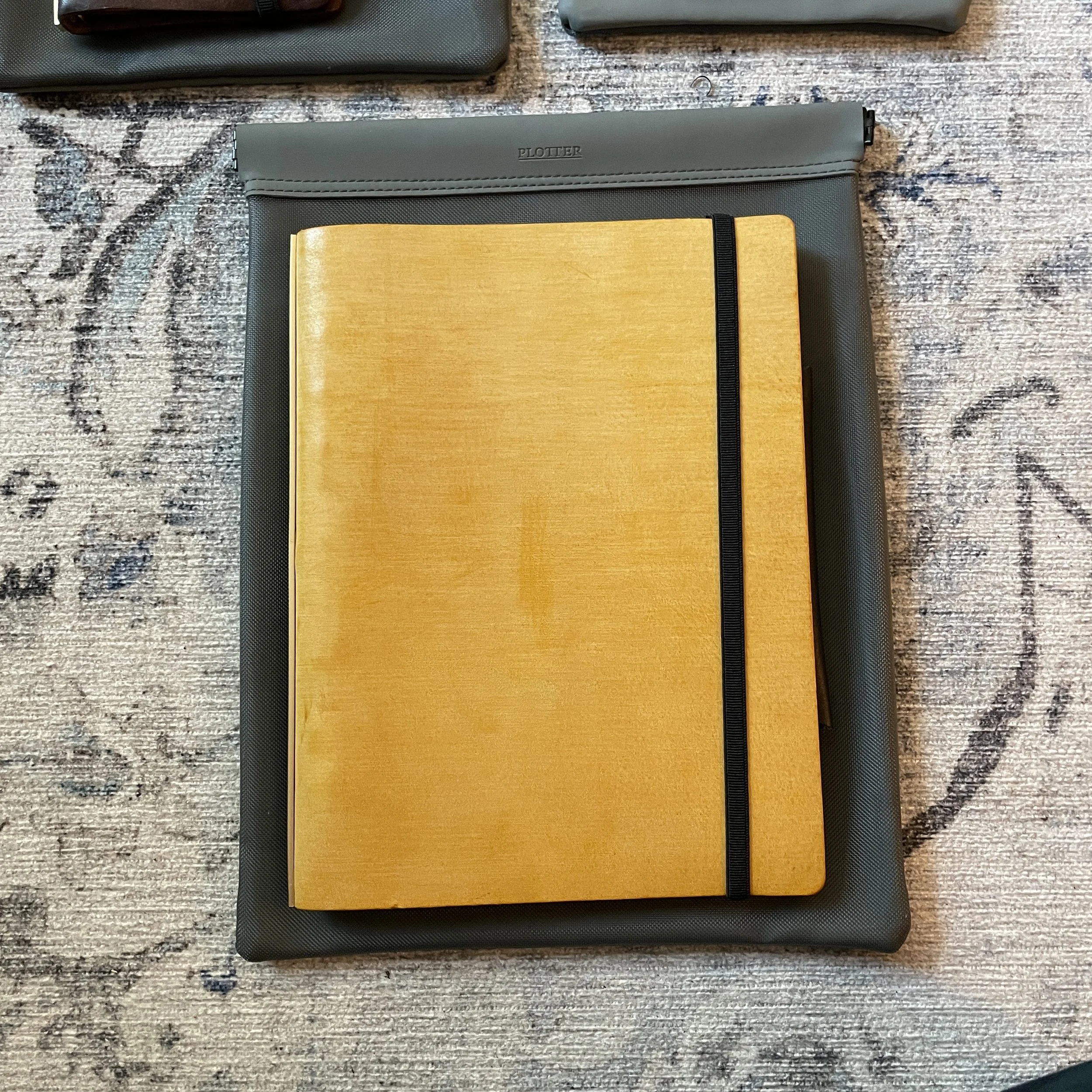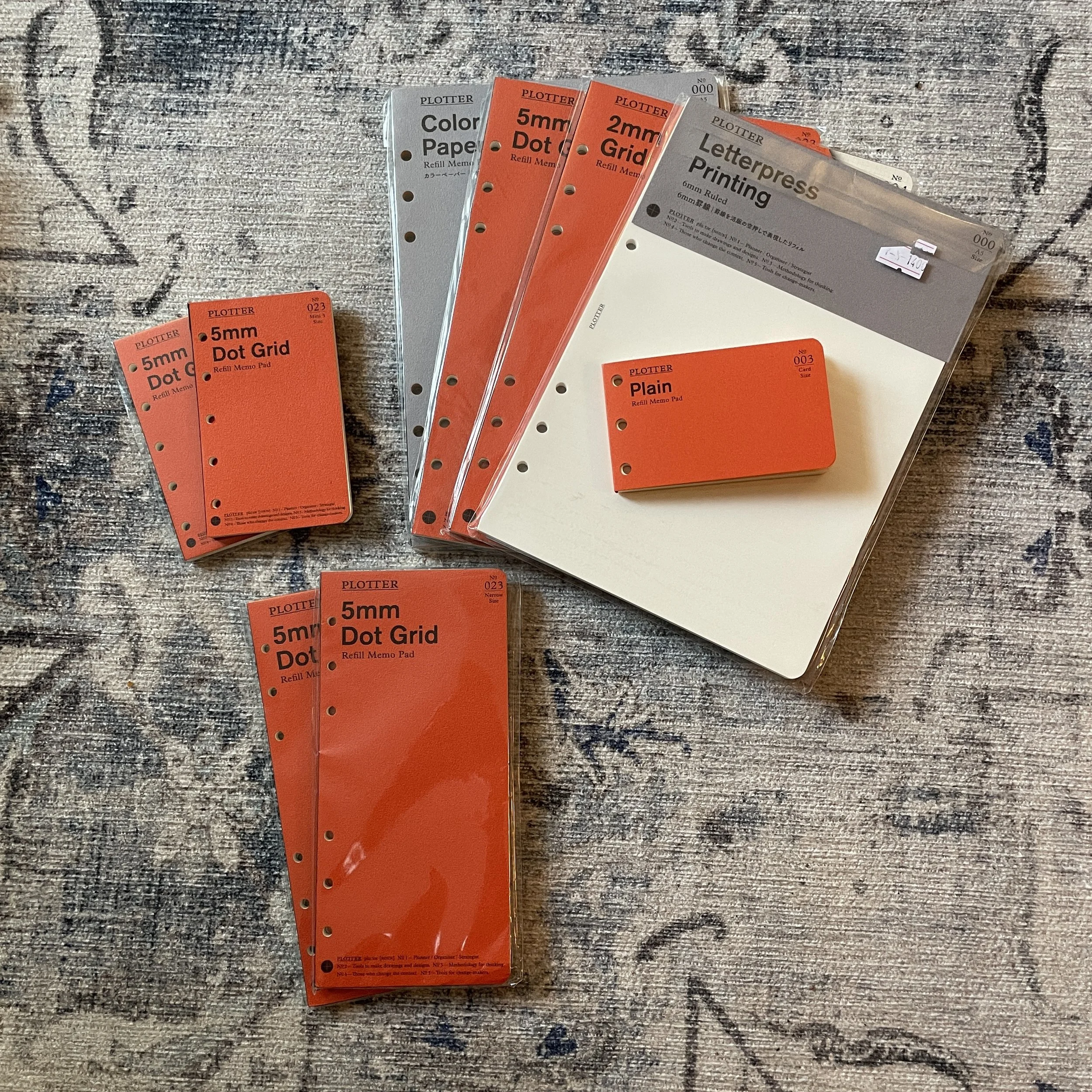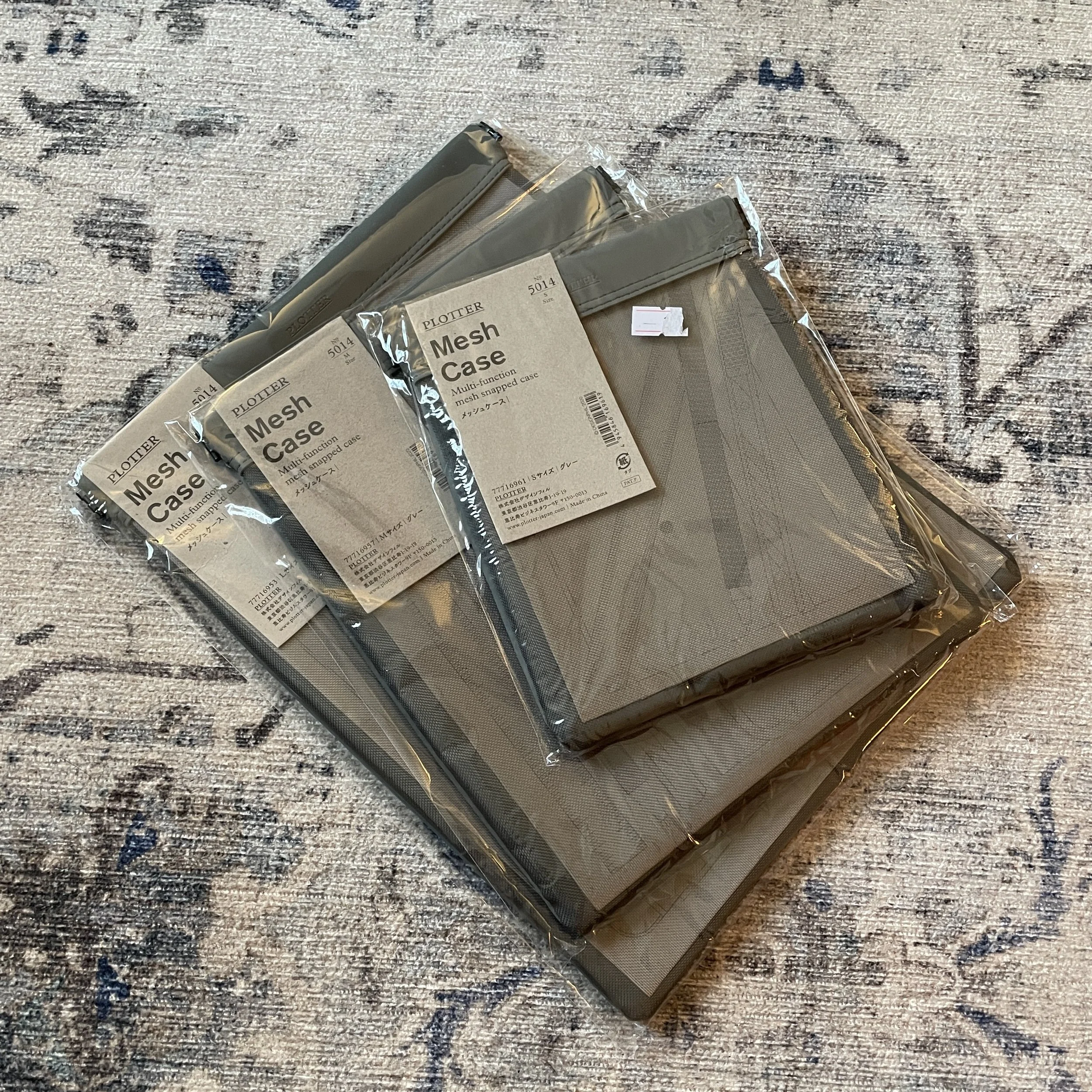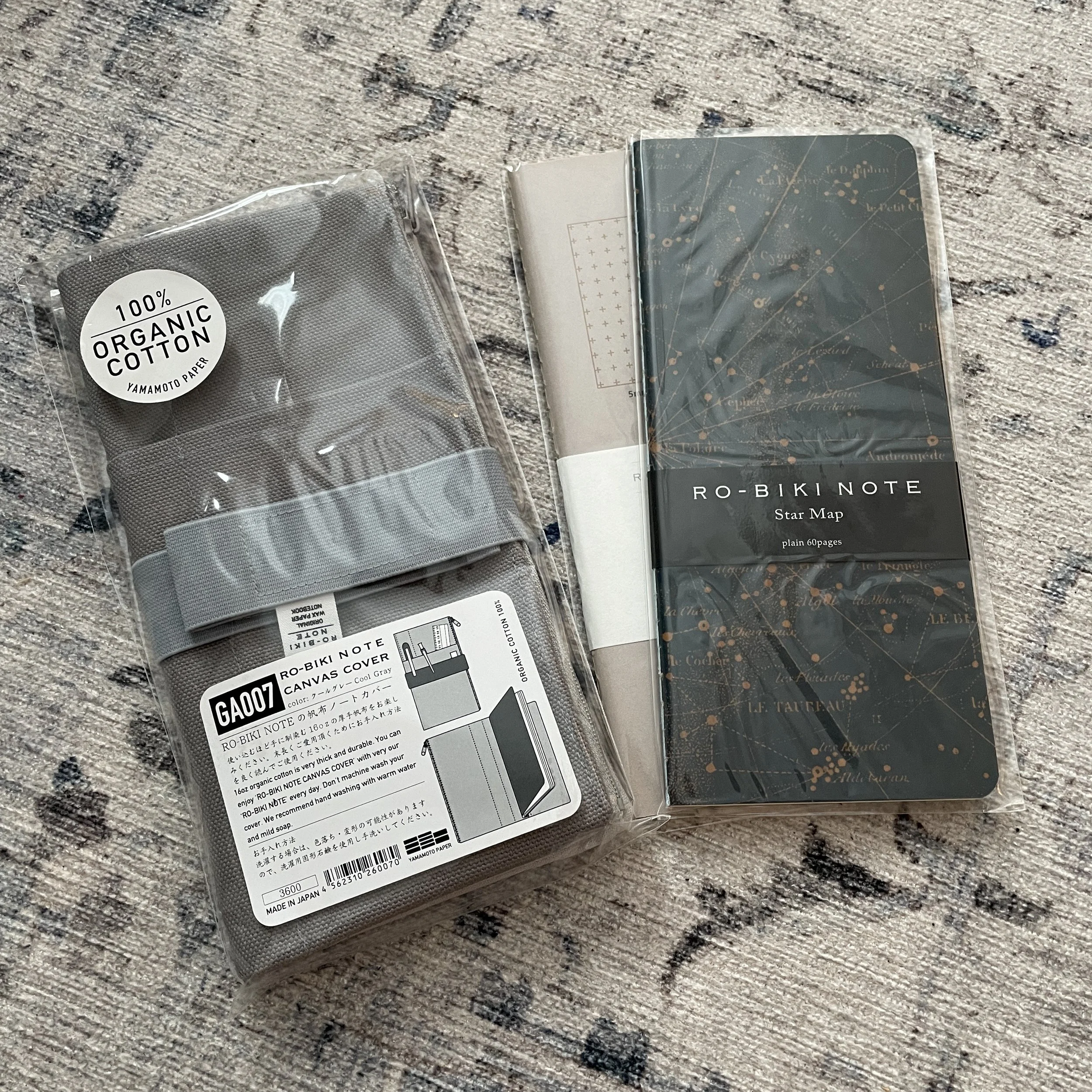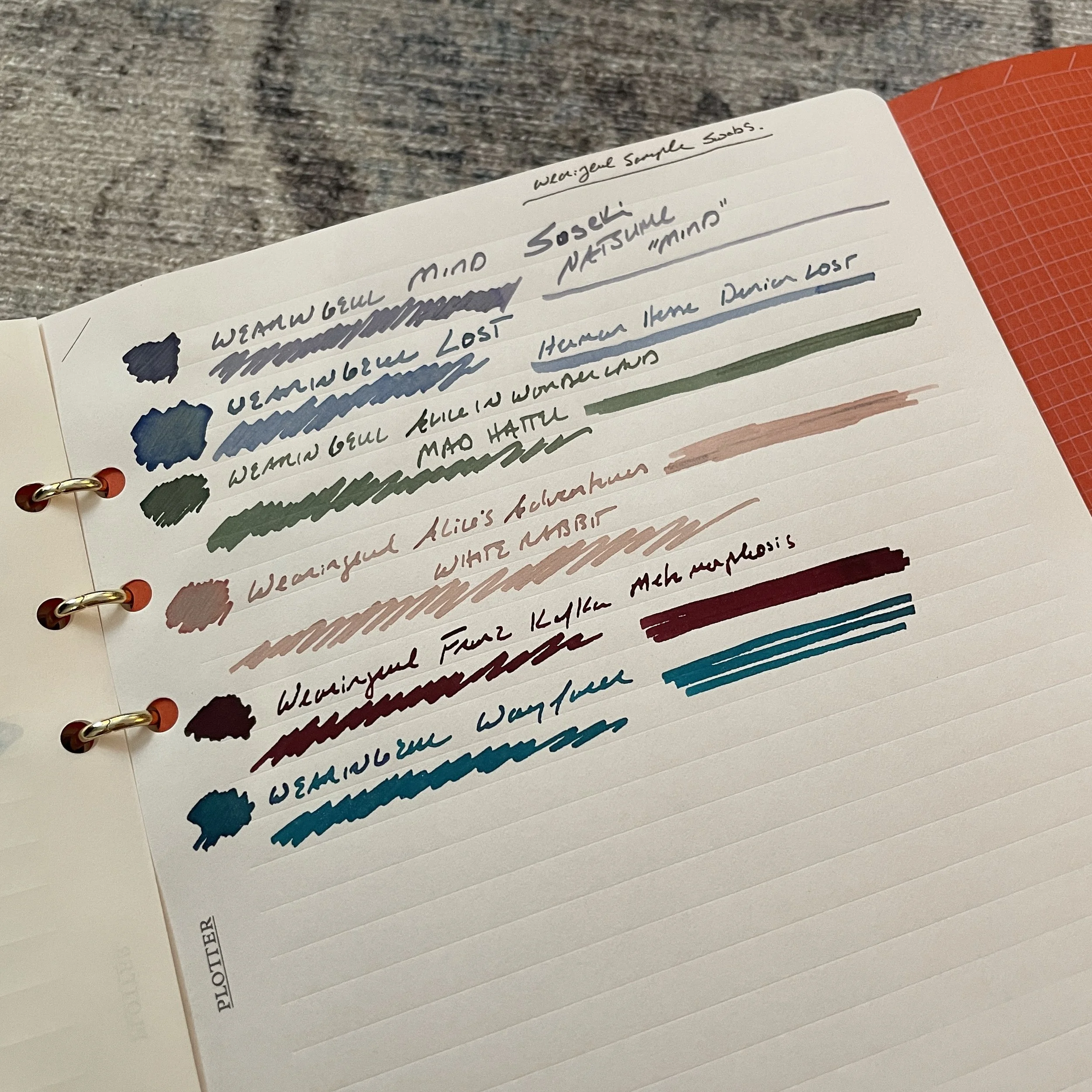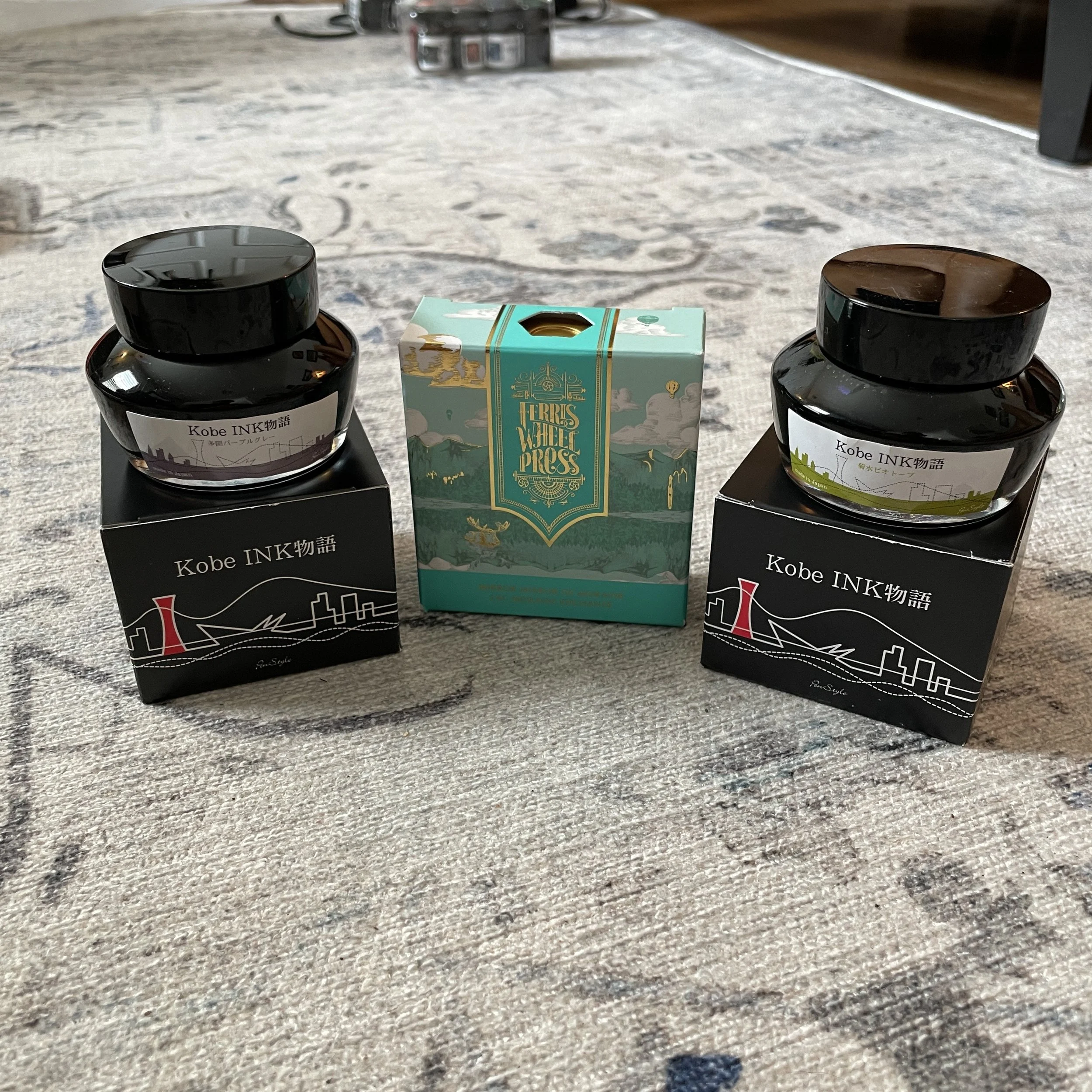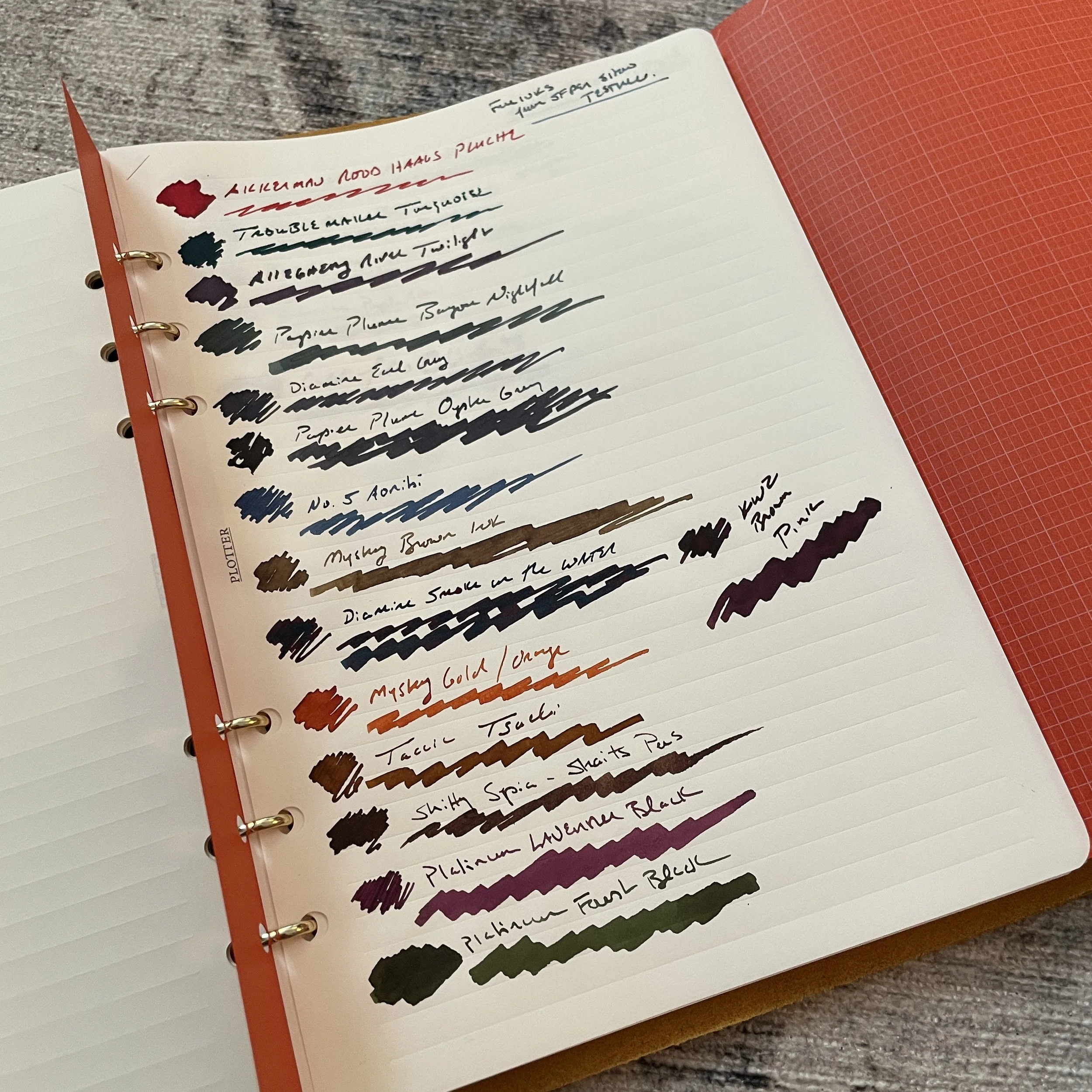In my main recap earlier this week, I talked about how the San Francisco Pen Show is a different kind of event, with a focus on classes, seminars, and community in addition to the typical pen show shopping extravaganza. Well, for all of those who have been asking for photos of my show haul, this is it, and it was a bit of a doozy. I rarely do “haul” posts, but I thought it might be fun to walk through my San Francisco pen show experience photographically, discussing each of my purchases/acquisitions by category, since what I ended up taking home from this show says a lot about the feel of the show and how I hope more shows evolve in the future.
Paper = Mostly Plotter
Earlier in August, I was on the fence whether to attend the San Francisco Pen Show at all, and then Plotter announced that they would be on-site with their creative director, Takayuki Saito, hand-assembling special-edition binders in specialty leathers that would only be available at that show. OK, I was in.
My yellow Plotter A5 being hand-assembled and adjusted.
At last year’s San Francisco Pen Show (2021), I was gifted the “Narrow” in brown “Pueblo” leather as part of Plotter’s US launch, when they sent out review kits to get feedback on the product in advance of a broader release. I’ve used my Narrow Plotter as my primary T.G.S. business notebook for the better part of a year, though I’ll admit it took me a while to get a feel for the system and discovery how it fits into my particular workflow. To be honest, it was more a factor of me being out of the “ring system” mentality for the better part of a decade and having to rethink how I could incorporate the ability to organize and shuffle pages around. Having now used the system at some length, perused the full range of refills, and visited with the people behind Plotter (both the U.S. and Japanese creative teams), I feel like I understand the system a bit better and there are definitely aspects that could drastically improve my research and writing process, as well as my daily capture of thoughts I don’t want to lose/miss.
Plotter: Infinitely customizable. You can make the system as intricate or as simple as you desire.
I had my personal Plotter appointment at 11:56 on Friday morning. (The time intervals were very precise, which is not strange at all for someone who has tracked their life in six-minute increments for the past 17 years.) But before my booked time slot, at which I planned to purchase a Plotter A5, Saito-san’s own personal Plotter Mini-5 caught my eye. The Mini-5 is a newer size, at least in the U.S. Market: a wallet-sized Plotter that appeared to be wallet + pocket notebook + penholder solution for which I’d been actively searching for years. I bought one in grey Pueblo leather, to match my “aged” Baron Fig wallet.
Later that afternoon, as I watched Takayuki Saito - Plotter’s creative director - assemble my binder (A5 ochre/yellow leather with gold trim), I started thinking about the accessories I needed and how I would use the Plotter system. I ended up purchasing a wide selection of add-ons and different refills to set up each Plotter for the various roles I have planned for each size. While most of this will be featured in a longer series on Notebook Systems/System Techo that I have in the works, I’ll give a brief photographic overview below:
My Plotter Mini-5 in grey Pueblo leather has replaced my wallet since approximately an hour after I bought it. If you intend to use it as a wallet, you’ll need at least one of the cardholder accessories. The pen loop is also an add-on, if you want to carry a pocket pen. (The one shown here is a Penco “Perfection” Bullet pen - back in stock in the shop!)
My Plotter Narrow (in more worn/aged brown Pueblo), vs. my Mini-5 in grey Pueblo. The mesh bags seen behind them are one of the more intriguing Plotter accessories that I ordered after the show, and were delivered yesterday. The Narrow will remain my TGS business notebook for checklists, posting schedules, etc. The Mini-5 will serve as my wallet and pocket notebook.
My yellow Plotter A5 - I’m not sure what this leather is called, or whether it will be generally available, but it’s gorgeous and about as close to my beloved natural undyed leather as you can currently get in the Plotter lineup. This one will age beautifully. I intend for this notebook to serve as a general purpose creative and idea inbox - a place to sketch out ideas before moving them into storage or figuring out where they will permanently live.
A Plotter group shot so you can get a sense of the different sizes in relation to one another.
Plotter refills in various sizes and rulings. One of the unique things about Plotter “refills” is that many are sold as bound pads that can be used as stand-alone notebooks. That way, you can selectively choose which sheets to remove and store in your binder. I’ll discuss this concept in more depth as part of a forthcoming review, but Plotter is not necessarily a planner system - you can use it that way, but it was originally conceived as curated binder system allowing you to carry with you those ideas that you’re currently working on, while archiving others elsewhere.
If you’re a fan of compartmentalized packing, bag-within-a-bag organization, etc., I highly recommend the Plotter Mesh Cases. Each case has a hinged opening that securely closes, two interior compartments, and while they are sized for the various Plotters (as shown in my pictures above), you can use them for an infinite number of other purposes.
I didn’t limit the “paper” theme of this show to Plotter. On Saturday, I scored a seat in the “paper tasting” seminar with Taizo Yamamoto and Bruce Eimon, and following that fascinating hour and a half session, picked up ten different memo pads full of unique, fountain-pen friendly Japanese papers at the Yamamoto Paper booth. I later discovered that the small square memo sheets can be hole-punched to fit perfectly into the Plotter (or any standard six-ring binder), should you want to keep any loose notes.
My takeaways from the Yamamoto Paper class and table!
Of these five, the Sleight White and the Soliste papers were the ones that pleasantly surprised me.
I doubled down on Soliste, though the textured Air Mail Bond White was also a lightweight favorite. I’m going to buy some full-size sheets because I suspect it will make for excellent typewriter paper.
The Memo Boxes themselves are well designed and useful. I really hope these become more readily available outside of pen shows.
You can use a standard Rapesco or Filofax hole punch to insert notes into the Plotter system (or whatever standard six-ring system you use). Plotter rings are not proprietary, so you don’t need to purchase an expensive proprietary hole punch to use your own paper with the system.
While I was at the Yamamoto Paper table, I also spotted some of their Ro-Biki Notebooks along with a cotton wrap-style case. Since it’s a long-narrow format, the Ro-Biki notebooks caught my eye, and I picked one up for experimentation. While most Traveler’s Company refills are too wide for this particular wrap, I found that I can make the MD Cotton Letter pad from the B-Sides series work. Honestly, though, the artwork on the Ro-Biki is what drew me in (that and the rumor that they may be moving to the Soliste paper in the future, which I adore.)
The Yamamoto Ro-Biki Cotton Canvas Cover plus two refills.
I love the details on the “Star Map” Cover.
The Canvas Cover Folds over and closes with an elastic strap.
Pen Cases = Mostly Rickshaw Bagworks
The other big piece of news in advance of San Francisco was the re-launch of the Nock Co. Sinclair (aka the Arguably Greatest Pen Case of All Time), in collaboration with San Francisco-based Rickshaw Bagworks. Rickshaw brought at least one tubful of the new Sinclair “Model-r”, one of which I purchased, and Brad supplied me with another for review purposes. The Sinclair is still an outstanding pen case, and Rickshaw has made some slight adjustments to the design (with more possible as customizations).
The Rickshaw show sticker was also available - if you picked up a fortune cookie at the entrance to the show, the “Fortune” was, at a minimum, a free sticker from the Rickshaw table!
Ink = Finally, Some Wearingeul (Plus a Lot of Giveaway Freebies)
Later on Saturday afternoon, Jesi over at the Dromgoole’s table finally got me with the Wearingeul Inks. Once again, I’m blown away by how many different ink brands there are now, and how many new inks they can bring to market. Sure, some companies aren’t very creative and don’t pay attention to whether or not they’re duplicating colors that already exist, but others - like Wearingeul - continue to amaze me with unique muted colors that are interesting but still suitable for everyday writing.
I can’t pick a favorite. All of these are good, if not amazing.
Did I mention I can’t pick a favorite? The paper shown here is Midori MD Cotton - my new favorite paper for ink sampling, but in a test run Plotter refill where Plotter took A5 sheets and letterpressed lines into the cotton paper. Please do me a favor and e-mail Plotter USA now, and demand that they bring this paper into the standard lineup. It’s amazing. For now, I’ll have to settle for taking the standard MD Cotton A5 pad and punching holes in it.
Nagasawa was selling Kobe ink for $10 a bottle on Sunday. Was I really going to pass that up? Plus I picked up a bottle of Ferris Wheel Press Mirror, Mirror of Moiraine, which I’ve been obsessing over for the better part of a year.
Not a purchase, but I definitely acquired a few more bottles of ink from a giveaway box that was floating around the show. Somebody apparently took a radical approach to thinning out their collection, leaving it with Jesi at the Dromgoole’s table!
I swabbed for posterity/sampling far more bottles than I brought home!
Pens = All Ebonite
So, Joe, no pens? That was the plan, and I held out until Sunday, when I found myself eyeing Ranga premium ebonite pens over at the Peyton Street Pens table. Never having owned a Ranga pen, and loving ebonite in general, I acquired a dark red/black striated Bamboo model, as well as one of the Abhimanyu models in a green/yellow color. Ranga pens take No. 6 (and sometimes, No. 8) JoWo nibs, making them perfect platforms for nib customization.
The Ranga Abhimanyu (left) and the Bamboo (right).
I love the color variation on the section of this pen. It’s what sold me on this specific piece. All of the pens are different.
I’m not sure there’s a color of ebonite that could speak to me more.
Nib Grinds = Further Exploring Naginata Styles
I picked up four nib grinds: two Nag-architect hybrid nibs with ultra-fine points from The Nib Tailor, and a Mini-Nag and architect from C.Y. of Tokyo Station Pens (who I enjoyed meeting for the first time!). The Naginata-style grind deserves its own post, so I won’t write at length here, but the grind features line variation similar to an architect (thick horizontal, thinner vertical), with less definition and a slightly smoother feel, plus the ability to vary line thickness depending on the angle at which you hold the pen. Different nib grinders use different techniques and have their own style, so no two pens will be the same. You really need to experiment to find your preference with this grind, which is why I’ve requested nibs from various people and will be doing a longer comparison post in the future. (For reference, check out my review of the Custom Nib Studio “Perspective” grind, which so far I consider one of my favorite Naginata-style nibs out there.) As an FYI, Gena is now offering pre-ground Naginata-style and cursive italic nibs through Schon DSGN, at least at pen shows. I picked up one of the former and it’s really, really good.
Once again, many thanks to everyone who made the 2022 San Francisco Pen Show such a great experience. I can’t wait to see you all again next year! If you have specific questions about any of the products featured here, feel free to reach out.
** I have strategically omitted certain purchases from this recap since I did pick up some cool things for upcoming birthday and holiday gifts. (The recipients read the blog.) :)
This post does not contain affiliate links or paid sponsorships, and unless expressly indicated otherwise, the products purchased here were acquired with my own funds at full price. Certain of the Plotter refills I ordered online were subject to a discount code that was floating around the show. The Gentleman Stationer is supported entirely by purchases from the T.G.S. Curated Shop and the T.G.S. Patreon Program.
